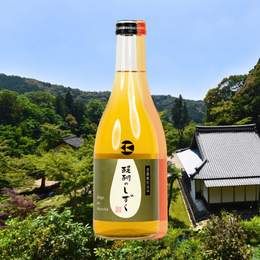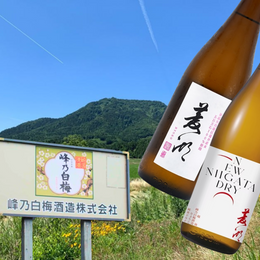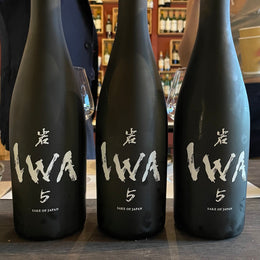The 300 Year Old Sake Brewery With The Flower Yeasts: Taste Testing 天吹 Amabuki's Banana Yeast, Strawberry Yeast & Sunflower Yeast Junmai Daiginjo & Junmai Ginjo

Have you ever wondered what actually makes a flower emanate the unique aromas that it does? Most anyone would be able to pinpoint at the very least the colour of the flower from just its aromas alone, and yet beneath that very romantic notion of a flower's all encompassing beauty which hits on every one of our senses, the truth is that a flower's scent comes of course from its biology. Special cells within the flower create these aromatic compounds - technically known as volatile organic compounds - which are then emitted to attract or even repel depending on what the flower's evolution has adapted to achieve. Some flowers are perennially in bloom whilst others bloom once every 10 years!
And so it is in Saga Prefecture in the south of Japan that one 300 year old brewery, Amabuki, has dedicated much of their modern history to exploring these floral aromas through the use of flower yeasts. But for us to understand its origins, we have to dial it back just a little bit.


Amabuki Brewery.
20 years ago in a lab at the Tokyo University of Agriculture, legendarily known as Nodai by the Sake brewing community (having produced numerous renowned brewers), one Professor Hisayasu Nakata had spent years at the helm of its brewing and fermentation program where he had been heavily focused on isolating flower yeasts. Unlike traditional Sake brewing yeasts, the yeast of flowers are significantly more fragile and temperamental, making them incredibly hard to isolate, stabilise, propagate and survive through fermentation.
For those same reasons, a big part of why Sake has grown to be the substantial industry that it is comes down to the foundations laid down in the early 1900's to establishing the Brewing Society of Japan, otherwise known as the Jozo Kyokai, which has for over a century served as a benchmark pillar of support for Sake breweries across the country. The missions of the Jozo Kyokai hence is to ensure and maintain the high standards of Sake brewing which then serves as the backdrop to uplifting the reputation of Japan's most prominent alcohol. In endeavouring to do so, the Jozo Kyokai provides what is known as Association Yeasts, or Kyokai Kobo, which are numerically numbered yeast strains that have been isolated by several key breweries over the century, which have proven its ability to reliably produce high quality Sakes. Kyokai No. 6 for example was isolated by the legendary Aramasa brewery in 1930 and is known for its ability to ferment at low temperatures with little spoilage, whilst Kyokai No. 7, also the most widely used Sake yeast, was isolated by the historic Masumi brewery in 1946 for its vibrant flavours. These Association yeasts are therefore safeguarded by the Jozo Kyokai to be made available for all Sake breweries to use.

Sotaro Kinoshita of Amabuki Brewery.
Yet Professor Nakata had been particularly fascinated with flowers and their powerful and unique aromas, and after many years of research, was finally able to successfully isolate and propagate flower yeasts which were able to produce Sakes with the same aromas and flavours as that of the very flowers they came from! Envisaging a powerful alternative to the traditional Sake yeasts, Professor Nakata would thus approach a pair of brothers who had been his students, Sotaro and Daisuke Kinoshita. The Kinoshita brothers had studied fermentation under Professor Nakata in preparation for their taking over the helm of their family's Sake brewery, Amabuki, and were of course well versed with Professor Nakata's work. Having received Sake samples from Professor Nakata, the two brothers were so impressed with them that they had immediately declared that these would be the new era for Amabuki (which translates as "Heavenly Flower"). This would thus set off Amabuki's entire focus on showcasing these flower yeasts and their influence, creating with them some of the most incredibly unique Sakes in Japan.

Over the past 20 years, Amabuki has worked closely with Nodai to isolate the yeasts of flowers from apple to sunflower, strawberry to marigold, and even the likes of Marvel of Peru and begonias, which has since led to the brewery's fascinating discovery of how these various flower yeasts are able to produce certain families of flavours.

Isolated flower yeasts at Amabuki Brewery.
Today, these flower yeasts remain incredibly difficult to access and are largely kept within Nodai's alumni. On the rare occasion that these flower yeasts are released, it is only when a major commemorative project is undertaken. One such example was the marking of the end of the Heisei Era in Japan in 2019, when Nodai's current chief Professor Takayuki Kazuoka would thus isolate the yeast of the rose flower to pay homage to the orange rose that was gifted to Princess Michiko (later Empress and now Empress Emerita) from the British Royal Family in 1966, which were then used by seven leading Sake breweries, all seven of which helmed by Nodai alumni, to each brew a Sake for the occasion - the proceeds from the Sakes were then donated to help those affected by Japan's natural disasters that year, and in particular farmers whose fields were flooded.

Rose Yeast Sake made by Nodai alumni in commemoration of Princess Michiko's reign through the Heisei Era.
And so today we're going to try three Sakes from Amabuki - the Banana Yeast Sake Junmai Dainginjo, Strawberry Yeast Junmai Ginjo and the Sunflower Yeast Junmai Ginjo!
PS. Shout out to Inter Rice Asia which consistently brings in some of the most incredible Sakes - all impressively vetted personally by the folks at Inter Rice Asia - which were on display at Singapore's Sake Matsuri which has consistently been the go to festival for any Sake lover, with hundreds of Sakes made available to be tasted and to be taken home!
Let's go!
Sake Review: Amabuki Junmai Daiginjo Banana Yeast 天吹 純米大吟醸 バナナ酵母 生
Now as it turns out, this Sake isn't actually made with Banana yeasts - it was named as such because of the vibrant Banana aroma that it gives off, nevertheless it was made from a flower yeast, however the exact flower yeast is kept a secret by the brewery and can't be disclosed! Local Jugemu rice is used here, polished to 50% rice polishing ratio.

Tasting Notes
Colour: Tint
Aroma: Very aromatic! It's got a great plushness to its aromas, delicately flour-y and doughy even, with then bounties of pink and white florals. Roses, rose water, rose Turkish delight, rose mochi, it's incredibly vivid and perfumed. At its base is a candied quality of melon nectar and yellow banana hard candies. It's honeyed and candied with this expressive and hyper-realistic floral and fruity tones!
Taste: Medium-bodied here, it's rounded with heaps of ripened melons and honey. That honey combines with a savouriness to give teriyaki meats with just a touch of black pepper. It's supple, plush, and yet balanced between candied fruitiness and savoury sweet glazed meats.
Finish: A more mineral spring water steps forward, still keeping with those intense tones of ripened melons, with the teriyaki savouriness taking a step back. Seamless finish with a lingering savouriness.
My Thoughts
Wow! This had the most incredibly vivid aromas! It was so vibrant and expressive with all these perfumes of roses, combined with an almost confectionary quality to give all manners of rose scented sweets! This plushness of the aromas carried through to the palate, here alittle more centered on the classic melons and candied savouriness, yet still incredibly juicy and supple - so flavourful and with such a great richness! The finish brings with it some really lovely mineral tones, before then going full blast on those ripened melons, with then a lingering of that teriyaki savouriness. This was wildly enjoyable! It's easy to drink and love, and also just really approachable with an understated complexity and balance that hides behind that beguiling juiciness!
Sake Review: Amabuki Junmai Ginjo Strawberry Yeast Unpasteurised 天吹 純米吟醸 いちご酵母 生
We move next to a Sake that's made with Strawberry yeast that is harvested from strawberry blossoms. It's made with Omachi rice that's been polished to 55%.

Tasting Notes
Colour: Clear
Aroma: Doughy and flour-y, it's giving delicate scents of strawberry kombucha, with a yeastiness that's almost reminiscent of long lees aged Champagne. At its core is a gentle almost jammy quality of strawberry preserves.
Taste: Medium-bodied here, really rounded and with a good richness. Lots of ripened melons along with a touch of black pepper and also that sweet savouriness of grilled glazed meats. Really supple yet firm.
Finish: The strawberries roar back into the finish with heaps of fresh and juicy strawberries, strawberry daifuku, with then also a rice grain nuttiness. It's rich and seamless through the finish, ending off with a savouriness.
My Thoughts
This was a pleasant surprise! It's not quite giving strawberries in the way you think - it comes through rather delicately yet with a really juicy, almost suppleness and freshness, often combining with this doughy quality as well. It's gentle yet when you catch it, it becomes very apparent, mainly showcased aromatically and into the finish. It traverses the range of strawberry tones from fresh strawberries to strawberry confectionaries and also strawberry jams in the most lovely and elegant manner, really pure and fresh, rather that being quite so in your face and literal. I really enjoyed this and in particular really liked that doughy quality which combines so beautifully with the strawberry tones!
Sake Review: Amabuki Junmai Ginjo Sunflower Yeast 天吹 純米吟醸 ひまわり酵母
This is made with Sunflower yeasts that Amabuki seems to deem their most complex in terms of flavour, not quite being so fruity yet at the same time not totally floral either. It's made with Sake Komachi rice that's polished to 55%.

Tasting Notes
Colour: Clear
Aroma: It's got a delicate and subtle almost dry and dusty nutty mustiness, that's then backed by candied melons. It's a nuttiness reminiscent of sunflower seed shells and dried corn kernels. Really aromatic in a uniquely earthy way!
Taste: Medium bodied here with a good richness, it leads with candied melons and that honeyed savouriness of teriyaki meats. It's got a background note of dry nuttiness and also vibrant yellow bananas, which starts off rich and yet develops and narrows to this core of sunflower seeds with a delicate sweetness of steamed yellow corn. The yellow bananas here are fresh and incredibly bright and vibrant!
Finish: That deep candied savouriness carries through, now giving flambeed bananas, with also more of that nutty husk of sunflower seeds and dried corn kernels. It finishes with a delicate earthy and nutty dryness.
My Thoughts
Super interesting! It really (and somewhat surprisingly) has tones of sunflower seeds, with then this very intriguing dusty nuttiness that has such depth to its aromas and taste, yet not exactly easy to pinpoint. It often feels like something between sunflower seeds and dried corn kernels, with also a delicate sweetness of steamed corn. It has an almost lightly dry and tannin, grainy quality. There's also those more classic flavours of melons and teriyaki meat savouriness. Into the finish, this banana vibrance begins to show more and more. There's alot going on yet it's subtle and really complex, and also really cohesive. Superbly interesting and thought provoking! This is one I'll definitely want to come back to time and time again just because it's such a mind-bender! That all said, it's really tasty and such an incredibly unique Sake with flavours I can't say I've come across before.
Kanpai!

@111hotpot






